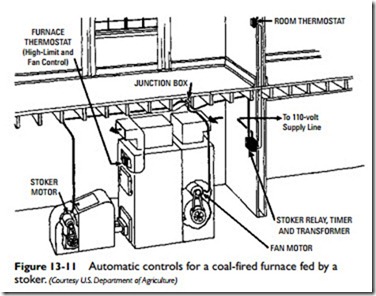Furnace Components
The basic components of a coal furnace used in a forced-warm-air heating system are:
1. Cabinet or jacket
2. Firebox
3. Grate
4. Heat exchanger
5. Blower and motor
6. Access door or doors for stoking and cleaning
7. Small blower to fan fire when more heat is required
8. Coal stoker (for automatic feeding)
9. Automatic controls
Each of these components is described in the sections that follow. Most of these components are also found in wood and multi- fuel furnaces. Additional information is contained in Chapter 10, “Furnace Fundamentals” and the various chapters in which furnace controls and fuel-burning equipment are described.
Note
Solid- and multi-fuel furnaces may also include backup devices such as a gas burner, an oil burner, or electric heating elements.
Automatic Controls
The automatic controls of a coal furnace equipped with a stoker are shown in Figure 13-11. This control system is very similar to the one used for an oil burner except for the automatic timer included with the stoker relay and transformer. During the heating season, the fire of a coal furnace must burn continually. The timer is a device designed to operate the coal stoker for a few minutes every hour or half-hour in order to keep the fire alive during those peri- ods when little heat is required.
A stack thermostat or similar device is recommended for use with stokers in areas subject to electric power failures. An electric power failure will shut down the stoker. If the shutdown period is long enough, the fire will die for lack of fuel. When the electricity comes on again, the stoker will feed coal to a cold firepot. A stack thermostat or light-sensitive electronic device will monitor the stack heat or fire and prevent the stoker operation when the fire is out.
A blower fan control is generally included with most forced- warm-air furnaces. Many manufacturers will also provide a hand- operated draft control with a coal-fired furnace. Electrically operated dampers for draft control are generally available, but at extra cost.
The operation of a furnace is controlled by the room thermostat. In heating systems in which a coal-fired furnace is used, the thermostat opens or shuts dampers to increase or decrease the supply of air to the fire. When the supply of air is increased, the fire becomes hotter, and the amount of heat generated by the furnace is increased. Decreasing the supply of air to the fire has the opposite effect. Older coal-fired furnaces were not controlled by a room thermostat. Hand-operated dampers were used instead.
